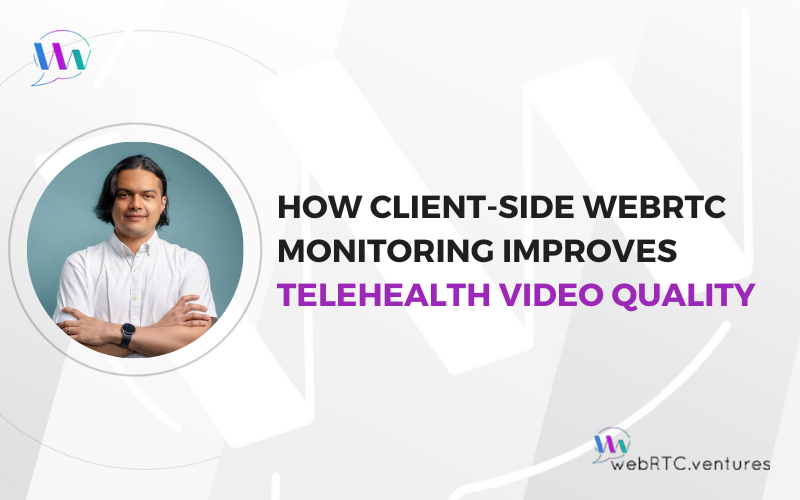Zoom’s WebRTC-powered Video SDK for web is a valuable tool for businesses and developers looking to deliver modern, browser-based real-time communication experiences. By combining the accessibility of WebRTC with Zoom’s enterprise-grade infrastructure, the SDK enables rapid integration, robust performance, and a wide array of features for custom video solutions. For organizations already using Zoom, it offers the added advantage of leveraging existing adoption to seamlessly integrate familiar video capabilities into custom workflows.
In this post, we’ll explore Zoom’s shift to embrace WebRTC technology, examine the key benefits this brings to developers and businesses, and highlight the features that make Zoom’s Video SDK a powerful addition to the CPaaS ecosystem. We’ll also look at practical applications across various industries and how WebRTC.ventures can help you implement custom solutions that leverage the full potential of Zoom’s WebRTC capabilities.
When Zoom Embraced WebRTC: Implications for the Ecosystem
WebRTC.ventures has long championed the open, flexible, and standards-based approach that WebRTC brings to real-time communications. The Dec 31, 2024 announcement that Zoom’s Video SDK for web would now incorporate WebRTC into its real-time media stack was a significant development for our industry.
Zoom’s proprietary video stack has historically been distinct from WebRTC, relying on custom implementations of codecs and media transport. The Zoom Web SDK previously ported parts of this stack into JavaScript and WebAssembly, resulting in performance and compatibility limitations in browsers, where native WebRTC shines.
With the release of Video SDK v2 for web, Zoom has added WebRTC support to its stack. This move brings several key advantages to developers and end users:
Greater Interoperability and Integration
By aligning with WebRTC standards, Zoom opens the door to easier integrations with other WebRTC-based platforms and services. This fosters a more connected ecosystem where developers can seamlessly bridge Zoom with other tools and workflows. Additionally, having a company like Zoom participating in libwebrtc is also helpful—even though Google primarily leads the effort— it encourages broader collaboration and ensures the technology remains robust and relevant for a wider range of use cases.
Enhanced Performance in Browsers
WebRTC’s adaptive bitrate and congestion control mechanisms handle fluctuating network conditions better than many proprietary stacks. Side-by-side tests show WebRTC’s faster adaptation to bandwidth changes and superior video quality under stress compared to Zoom’s legacy stack.
Improved Security Standards
WebRTC mandates strong encryption (SRTP) and adheres to strict security standards, providing a reliable foundation for privacy-conscious applications.
Industry Validation
Zoom’s adoption represents a strong endorsement of WebRTC’s maturity, robustness, and scalability as the backbone of modern real-time communications.
Why Zoom’s Video SDK Stands Out
Rapid Integration and Customization
The SDK provides pre-built components and APIs for video, audio, chat, screen sharing, and data streams, enabling developers to quickly build and deploy tailored video experiences. Whether you’re using Angular, React, or plain JavaScript, integration is streamlined and flexible.
Enterprise-Grade Reliability and Scalability
Zoom’s global infrastructure powers the SDK, delivering consistent HD video, adaptive quality, and support for large sessions. Built-in analytics, reporting, and session controls help you monitor and optimize user experience at scale.
Feature-Rich Communication
Zoom’s Video SDK supports a wide range of features, including:
- HD video and audio
- Live streaming and cloud recording
- Screen sharing and chat
- Real-time data channels for interactive applications
- REST APIs and webhooks for integration with business systems
Flexible Deployment Options
The SDK can be embedded in web apps or hybrid mobile apps (via WebViews), giving you the freedom to deliver video experiences on your users’ preferred devices.
Enterprise Ubiquity
Leveraging existing adoption is a compelling reason to use the Zoom Video SDK. If Zoom already has a strong presence in your organization, you can integrate and customize the platform your teams already know—rather than introducing new tools—within your own workflows.
Real-World Applications
The combination of Zoom’s infrastructure and WebRTC opens up exciting possibilities across various industries:
- Healthcare: Telemedicine platforms that work directly in browsers without requiring patients to download applications
- Education: More accessible virtual classrooms that integrate seamlessly with learning management systems
- Financial Services: Secure video conferencing for consultations that clients can join with minimal technical barriers
- Customer Service: Embedded video support options directly on websites for immediate assistance
- Events: Hybrid event platforms that combine the reach of web-based participation with the reliability of Zoom
Partner with WebRTC.ventures to Maximize Your Zoom SDK Implementation
Do you love Zoom’s video stability and user-friendliness? Now you can harness that same trusted technology to power your own custom video applications. Zoom’s WebRTC-powered Video SDK offers the flexibility of a CPaaS while leveraging the architecture and video quality you already have relied on. It’s the ideal solution for teams looking to build complex, browser-based video experiences—without starting from scratch.
As specialists in real-time communications, WebRTC.ventures can help business looking to:
- Design and build custom video solutions using Zoom’s Video SDK
- Integrate video features seamlessly into existing applications and workflows
- Get strategic guidance on leveraging Zoom’s SDK for your unique business needs
- Be supported from concept to launch with expert development, deployment, and ongoing optimization
Ready to explore what’s possible with Zoom’s Video SDK? WebRTC.ventures is here to help you bring your vision to life. Contact us today to discuss your project and discover how we can help you leverage this exciting new capability.












